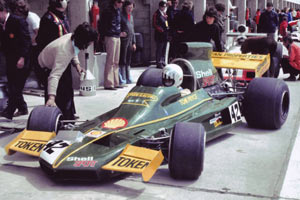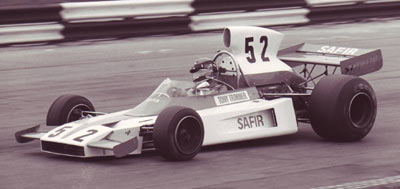Token RJ02 Cosworth

Active: 1974
Team: Token Racing
Designer: Ray Jessop
Drivers: Tom Pryce (42), Ian Ashley (32), David Purley (42), Ian Ashley (35)
The Token Formula One car was designed as a small, potentially competitive Ford D.F.V. powered car, that could be constructed by a small organisation working within relatively tight budget. The unusual nose shape was deliberately chosen to give the car an identity of its own without sacrificing aerodynamic efficiency. The car was designed with latest specification inboard front brakes and provision was made for updating the basic chassis later by the addition of a number of advanced mechanical features new to racing car practice.
The chassis itself was a light alloy monocoque with built in crushable foam safety structure, integrated to a fully stressed rear engine and gearbox assembly. Fuel was carried in safety tanks at both sides of the driver. The oil tank, fuel system and electrics are between the driver and engine for ease of servicing.
Powerful Lockheed ventilated disc brakes were mounted inboard front and rear. Provision was also made for outboard front brakes that allowed comparative tests (front: 11.6 x 0.8, ventilated discs / rear: 10.5 x 0.8 ventilated discs. Front discs strap drive. Front brake shafts solid with Hardy Spicer C.V. Joints). Due to development problems experienced by Lockheed, similar system on Tyrell, the car was run only with outboard front brakes.
As the car, sponsors, team and driver represented an all-British combination, it was raced in the National colour of green with yellow trimming, similar to Jim Clark's Lotus in the days before sponsorship.
Tom Pryce drove the Token for the very first time during practive for the International Trophy race at Silverstone in April. Tom started from the backrow of the grid, to to only 4 laps of practice. He retired from the race due to gear selector problems in lap 15 after having moved up the field. The first real grand prix was at Belgium. The nose was however damaged early in the race leading to an eventual retirement after getting a knock by one of the race leaders.
Despite having a solid basic design, the Token's long term development depended on sponsorship which should have been signed immediately after the Monaco GP. Unfortunately, the sponsors there turned up only to see that the Token was not allowed to compete due to the FIA not allowing new entries to practice for a place on the grid. Tom Pryce however won the F33 race at the venue, leading to him being enticed away by the Shadow team.
The F1 entry problem prevented participation until the British GP at Brand Hatch. David Purley just failed to qualify for 26th. Ian Ashley then drove the Token at the German GP, starting as first reserve when Denny Hulme shunted on the start. He finished 14th. The same Ian Ashley also drove the Austrian GP, qualifying successfully and finishing in 12th place. The lack of adequate sponsorship eventually made this the last grand prix of the Token RJ02.
 Designer Ray Jessop declared, "Although the Token project has been rather an uphill struggle, mainly due to unpredictable factors outside our immediate control, I am satisfied that the Token is basically a very competitive F c1ar. It is not essential to have a large organisation with an enormous budget, in order to compete successfully in F1. It does, however, need a well engineered car, a really fast driver and sufficient financial backing to cover basic racing costs, with the prospect of very little racing income until the team becomes an established front-runner."
Designer Ray Jessop declared, "Although the Token project has been rather an uphill struggle, mainly due to unpredictable factors outside our immediate control, I am satisfied that the Token is basically a very competitive F c1ar. It is not essential to have a large organisation with an enormous budget, in order to compete successfully in F1. It does, however, need a well engineered car, a really fast driver and sufficient financial backing to cover basic racing costs, with the prospect of very little racing income until the team becomes an established front-runner."
The car ran a total of 125 grand prix laps before being handed over to Safir Engineering at the end of 1974. They ran it for two events in 1975 (namely the Race of Champions and The International Trophy). On both occasions it was driven by Tony Trimmer, and finished in 12th and 14th places respectively.
Specifications
Chassis designation: RJ02Number of chassis built: 1
Front suspension: Independent, fabricated wishbones, inboard front brakes
Rear suspension: Independent, parallel bottom links, coil spring on dampers
Suspension dampers: Koni
Wheels: Magnesium alloy
Wheel diameter: front: 13" / rear: 13" or 15"
Wheel rim width: front: 11", 10" / rear: 18" or 17"
Tyres: Firestone
Brakes: Lockheed 4 pot calipers ventilated discs
Brake pads: Ferrodo
Steering: Jack Knight Rach & Pinion
Radiator: Serck front mounted
Fuel tanks: Marston Excelsior rubber bags (4 side tanks)
Battery: Varley
Instruments: Smiths
Dimensions:
- Wheelbase: 96"
- Front track: 62"
- Rear track: 63"
- Weight: 1290 lb
- Chassis weight (tub): 80 lb
- Fuel capacity: 44 gallons
Gearbox: 5-speed, Hewland F.G.A 400
Gearbox weight: 98 lb
Driveshafts: Hardy Spicer C.V. Joints, Token Shafts
Clutch: Automotive Products Borg & Beck
Clutch lining: Ferrodo
Engine specifications
Type: Cosworth Ford DFV (3.0 l, V8), standard 1974 specification
Fuel system: Lucas
Fuel & oil: Shell
Ignition system: Lucas
Sparking plugs: Champion
Power: 460 bhp
Fuel consumption: 6-7 mpg
Weight: 365 lb
